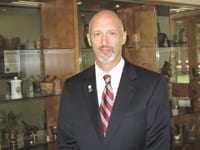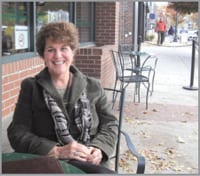Going According to Script – WNEU School of Pharmacy Graduates Inaugural Class
Evan Robinson knows the statistics, and he understands the societal trends and how they all point to one conclusion: it’s a great time to be a pharmacist.
“They are certainly in demand,” said the dean of the Western New England University School of Pharmacy. “We have an aging population, which is going to tax the healthcare system. And we have a healthcare environment in which patients have to be more independent and autonomous more than ever before. To that end, the community pharmacist is a valuable partner and a valuable contributor to patient care and patient outcomes. For those reasons, I think there’s a very sunny future in this field.”
Those signals were already becoming evident when WNEU made pharmacy its fifth school in 2011, enrolling an initial cohort of 75 students. This spring, 69 of them represented the first graduating class at the school — around the same time the program won an important accreditation from the Accreditation Council for Pharmacy Education.
“One of the reasons Western New England made the decision to open a School of Pharmacy was that we recognized strong job opportunities in a health profession with strong upside — one where people are able to really help others get better,” Robinson told HCN.
In fact, he has long touted the school’s philosophy of “pharmacist as educator,” recognizing that clinical pharmacists are often a key link between patients and doctors, and sometimes the only professional an individual with a health concern may talk to.
“That’s not to say we’re not linked to the product — the product is key to our profession — but, beyond that, pharmacists really have an opportunity to be teachers of patients or their allied health partners in patient care, and serve as that therapeutic expert, if you will, working to help people feel better and move quality patient outcomes.”
Statistically, it’s a role with much potential for career seekers.
The U.S. Bureau of Labor Statistics projects 14{06cf2b9696b159f874511d23dbc893eb1ac83014175ed30550cfff22781411e5} growth in jobs between 2012 and 2022, an increase of 41,400 positions. The annual median wage for pharmacists is more than $116,000.
“The pharmacy job market is showing some rebound, so that’s been good,” Robinson said, citing a recent wave of pharmacy-school openings and the recent sluggish economy as recent negative factors that, hopefully, will prove temporary. “It’s never been bad by any stretch of the imagination, but it tends to fluctuate.”
Pioneering Idea
WNEU was no stranger to pharmacy education before launching the School of Pharmacy four years ago. It had long boasted a pre-pharmacy program and had partnered with the Hampden College of Pharmacy and, later, the Massachusetts College of Pharmacy on joint programs until 1995.
Still, Robinson praises the recent class of graduates for taking a chance on a brand-new enterprise.
“We used to joke with them that they’re pioneers,” he told HCN. “They came in with a lot of expectations, a lot of aspirations, and not a lot of tangibles. They took that leap in a new building with no classes ahead of them; we were still hiring faculty. It was a fascinating thing for them. I give them a lot of credit.”
Just over half the inaugural graduating class moved right into positions in retail pharmacies, while others found jobs in hospitals and other clinical settings. Others sought out residencies, from which they may explore more specialized niches in the pharmacy industry, he explained. “It could be pediatric oncology, critical care, acute care, or emergency departments.
“Interestingly enough,” Robinson added, “we have two residency programs here at Western New England, one with Walgreens and one with Big Y. The idea is creating an environment in which someone who’s ready to be a licensed pharmacist can learn more about the practice at a high level, in a community-care environment, whether that means some clinical engagement or different types of health and wellness activities.”
The initial class that arrived in 2011 has been augmented with a new roster of 75 students each year, bringing the program to around 300 students today. Some move over from the pre-pharmacy program at WNEU, and others come from outside, with bachelor’s degrees in various fields.
The first three years of the program are spent on campus, while the fourth is entirely off campus, with a series of six rotations, each six weeks long, working in the field, guided by pharmacy ‘preceptors.’ That’s where the ‘learners,’ as Robinson likes to call them, start to apply their craft, learning how to fill prescriptions, make IVs, and, of course, educate patients.
The curriculum is designed to produce generalists trained to handle any entry-level position, he added. And, after increasing in number with each new incoming class, the WNEU School of Pharmacy now boasts a full complement of faculty and staff.
There remains some concern among pharmacy leaders over a surge in new pharmacy programs that produced 14,000 graduates last year after a trend of between 6,000 and 8,000 per year between 1974 and 2003.
Daniel Brown, a professor in the School of Pharmacy at Palm Beach Atlantic University and a nationally recognized thought leader on the pharmacy workforce, understands why those programs sprung up and why they are attractive.
“The pharmacist job market in the 1990s and up to about 2007 was characterized by a significant shortfall of pharmacists, fueled largely by a marked increase of community pharmacy positions in chain stores, supermarkets, and mass merchandisers,” he told Medscape.com last year.
“This made jobs plentiful and caused salaries to rise above six figures, understandably making pharmacists a very hot commodity. The lure of a guaranteed job with a high salary attracted many people to pharmacy, and the growing number of applicants created opportunities for new schools of pharmacy to be established and for existing schools to expand,” he continued, adding that he wonders whether that academic growth has exceeded the need.
Prescription for Growth
Still, the reports of WNEU’s first graduating class of pharmacists finding jobs in a variety of workplace settings is encouraging to Robinson.
“Consider our aging population and the fact that, in many instances, the community pharmacist is a uniquely accessible and available member of the healthcare team,” he told HCN, an idea driven home by the fact that more than 3.5 billion prescriptions are written each year, medications are involved in 80{06cf2b9696b159f874511d23dbc893eb1ac83014175ed30550cfff22781411e5} of all treatments, and Medicare beneficiaries with multiple chronic diseases take 50 different prescriptions per year.
In its 2014 National Pharmacist Workforce Survey, the Midwest Pharmacy Workforce Research Consortium predicted that these trends and others — like the high number of pharmacists, especially men, approaching retirement age — will continue to create opportunities in the field.
“We’re living in dynamic times as a health profession,” the report notes. “We have shifted from a male-dominated to a female-dominated profession. Male pharmacists will continue to retire in large numbers, given that almost 50{06cf2b9696b159f874511d23dbc893eb1ac83014175ed30550cfff22781411e5} of actively practicing pharmacists who are over 55 years old are male.”
Meanwhile, it adds, “more pharmacists are reporting their pharmacies are providing direct patient-care services. As coordination of care for patients with chronic conditions grows, the number of opportunities for pharmacists in new roles is likely to increase.”
Robinson has noted that fact as well. “This is an important role that benefits patients,” he concluded. “The pharmacist can serve not only as an educator, but an advocate.”
That’s why Western New England University is busy training more.




Comments are closed.